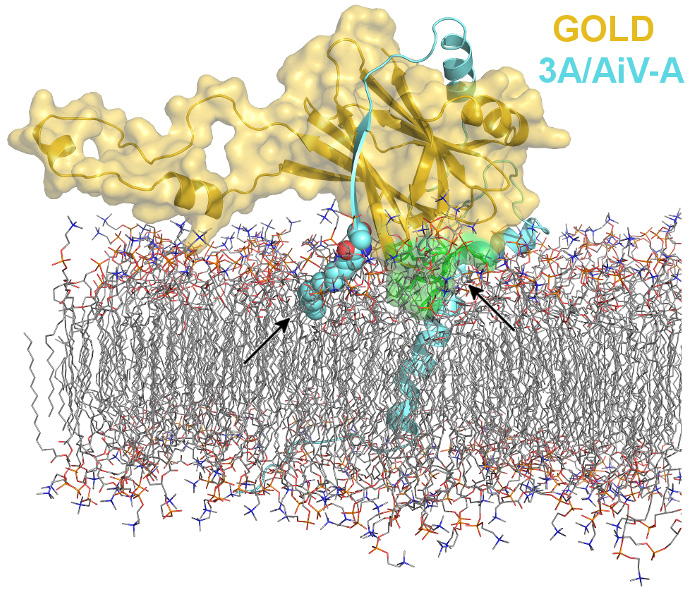Projects
1. Viral hijacking of human host factors
Viruses are way too small organism (not even considered living by many) to encode all the proteins they require to reproduce in our cells. Therefore, they evolved mechanisms how to hijack our proteins for their selfish benefits. We use protein crystallography to understand molecular principles of viral reproduction in our cells. Our research not only reveals the mysteries from viral life cycle but also provides new targets for drug design.

Molecular dynamics simulation-based model of the ACBD3 GOLD domain in complex with viral 3A protein based on our recent crystal structure (Klima et al. 2017) on the lipid bilayer. The viral 3A protein is colored in aquamarine and shown in cartoon representation except for the myristoylated G1 residue which is shown in spheres representation and colored according to elements - carbons are colored in aquamarine, oxygens in red, nitrogen in blue. The ACBD3 GOLD domain is shown in cartoon representation with semi-transparent surface and colored in gold except for the membrane-binding site composed of R399, L514, W515, and R516, which is colored in green.
2. Inhibitors of essential host factors as potential antivirals
An essential host factor is a protein that is hijacked by a virus to help its procreation instead of fulfilling its normal function in our physiology. For many +RNA viruses, such as HepatitisC virus or SARS, the essential host factor is an enzyme called PI4KB (phosphatidylinositol 4-kinase B). The goal of this research is to develop highly specific inhibitors of PI4KB that could be used as antiviral agents. Recently, we have solved the crystal structure of PI4KB with an inhibitor that was synthesized by our collaborators - the Radim Nencka group. The structure explains how the inhibitor works and it helped us to synthesize next generation sub-nanomolar inhibitors (Mejdrova et al. 2017).

3. Reconstitution of the key events of viral lifecycle
ACBD3 hijacked by viral 3A efficiently recruits and activates PI4KB
To reproduce in our cells, picornaviruses need membranes that are rich in the PI4P (phosphatidylinositol 4-phosphate) lipid and serve as viral replication organelles. The lipid is produced by the PI4KB enzyme. We use a biomimetic GUV (giant unilamellar vesicle) system to reveal how viruses build their replication organelles.


